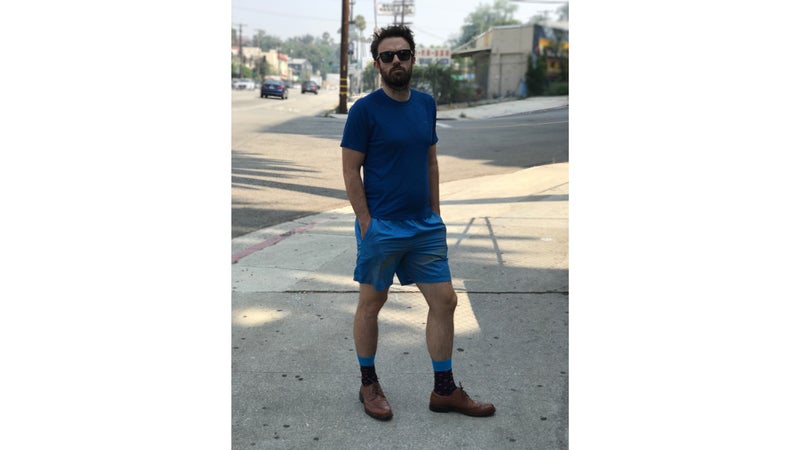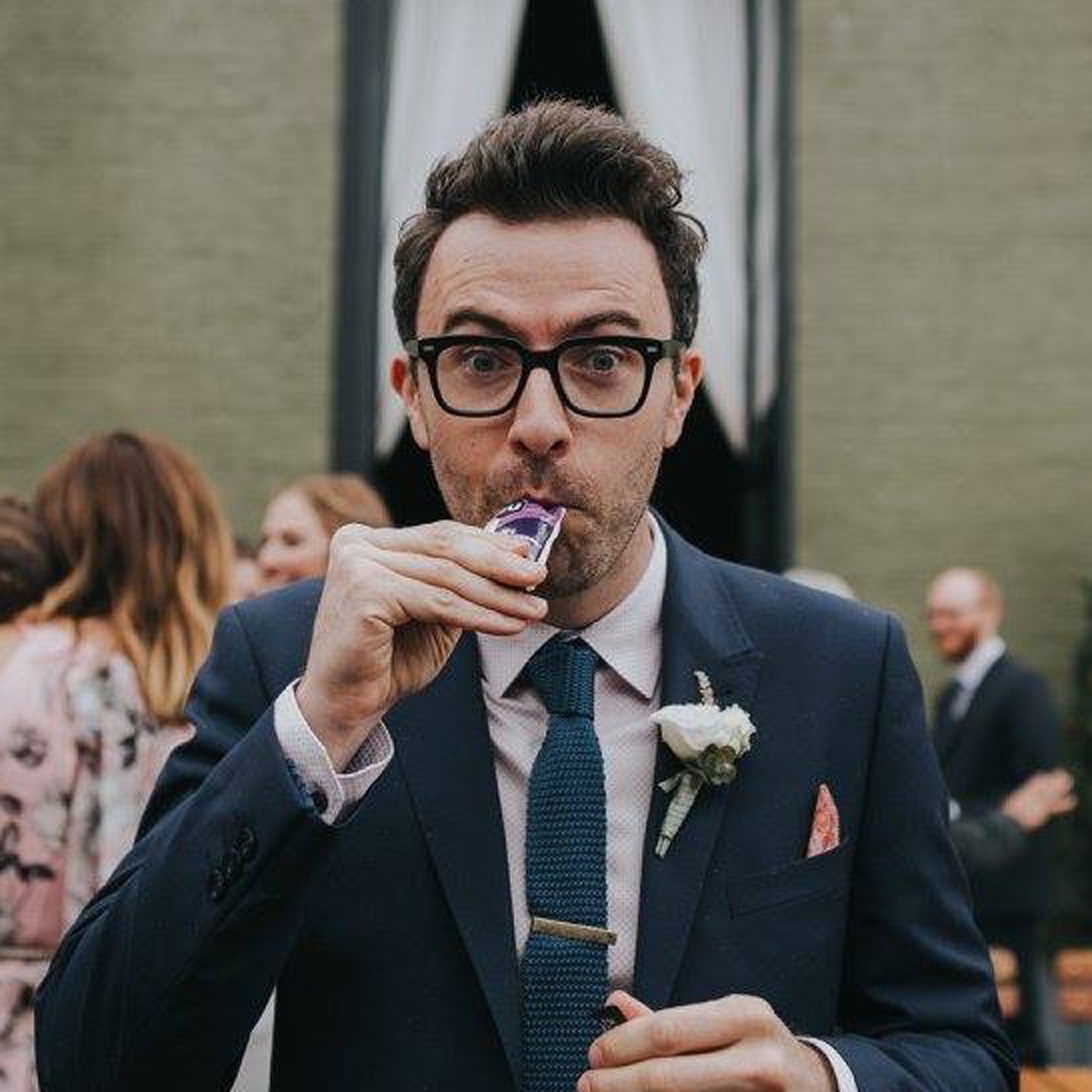A year and a half ago, I proposed to my beautiful girlfriend, Miranda. Once you get engaged, married types who have been through a wedding themselves will emerge from the nooks and crannies of your life to give you advice, solicited or otherwise, about the event.
Again and again, a common theme emerged in how the wedding day was portrayed: It would go fast, and it would be exhausting. The advice usually took the shape of telling me to be mentally prepared so it wouldn’t feel like a personal shortcoming when I became stressed and tired during what was supposed to be the best day of my life.
“Drew and I were totally jazzed after the ceremony, so we were like, ‘What are people talking about? We’re not tired. We feel amazing!’” my sister recounted about her nuptials. “Then our parasympathetic nervous systems gave out, and we crashed so hard. Don’t feel bad when it happens to you.” Aaron, a friend who is never afraid of honesty, told me not to feel bad if we weren’t up for visiting the marriage bed (not how he put it) after the ceremony. “Sam and I were so tired, we just went to sleep,” he concluded.
The message to me was clear: My wedding would be an endurance event, a test of my physical stamina. I decided to adopt a four-part training plan to be in peak physical shape for the big day.
Imitate What You’ll Be Doing on Race Day
We often allow the habits of our routine to dictate our training. When preparing for a hilly 5K, we run only the flat sidewalks around our neighborhood, and then wonder why we bonk as we crest a climb.
In Hal Koerner’s , he suggests that you become intimately familiar with the conditions you’ll be facing on race day and, as closely as possible, incorporate those conditions into your training regimen. In other words, if your race includes dirt trails, hills, humidity, and altitude, but you train on roads in a cool, dry climate, you won’t know how your body will react to all the additional stimuli when it comes time to toe the line.
I applied this same logic to the key moments of the wedding. As I saw it, the two points where I would require peak performance: reciting the vows and the first dance.
It was the dance that made Miranda and me especially nervous. Dancing is not something we had done as a couple. Ever. Publicly or privately. So, in the same way that Shaq habitually worked on his free throws in the off-season, we saw this as a weak area to be drilled.
A few months out, practice began. We played the Beach Boys’ “God Only Knows” on Spotify, turned on my laptop’s camera for future analysis of our performance, and started dancing.
“Are we doing it right?” Miranda asked as we shifted our weight.
“Yes. I mean, I think?” I said.
“Is that where your hand is going to go?” she asked.
“Maybe? I could try it somewhere else,” I said, moving my hand.
“Not there! My parents will be watching.”
The song ended, and we checked the footage. We looked like two middle-school students wearing Forrest Gump–style leg splints.
“OK, maybe a little looser this time?” We tried again.
Test Your Gear Ahead of Time
We’ve all been there. You bust out that exciting new tech T-shirt with the funky pattern on race day, thinking it will wick away sweat while making your fellow competitors give you kudos all the way to the finish line, only to realize one mile in that this particular fabric creates a .
The lesson: Race day should never be the time to try out your gear for the first time. Early on, I knew that footwear would be a gear hot spot for me. Whenever I have to make a choice between fashion and comfort, I choose comfort. With footwear, I typically wear running shoes or orthopedic walking shoes, so I was nervous about the prospect of slipping into a pair of fancy new untested shoes on wedding day.
A month out, I purchased a pair of Johnston & Murphy dress shoes from Macy’s. I started breaking them in. First while watching Netflix on the couch, then while walking around the apartment. They rubbed my heels a bit, but I thought they were ready for a street test. I started with a one-mile walk around a nearby park. I headed out wearing the dress shoes, paired with the sort of dress socks I’d be wearing on the big day. I estimated I would walk approximately five miles on my wedding day, the walking-in-dress-shoes equivalent of an ultramarathon across the desert. I needed to break them in.

The one-mile loop I embarked on was overly ambitious, and I limped back to my apartment with blisters forming.
“What are you doing?” Miranda asked as I staggered in the door.
“Testing my gear. And good thing, too. Not a very breathable upper, plus an overly rigid midsole. Definitely feeling some unwelcome friction in the heel. I’ll need some Moleskin for these.”
“But why are you wearing running shorts with dress shoes?”
“Oh. Just for fun.”
Assemble an Ace Support Team
During , he was able to withstand the 135 miles in temperatures reaching 120 degrees Fahrenheit with the help of a great support team. Specifically, his sag wagon followed him with a cooler of ice water in which Jurek would periodically submerge his entire torso to reduce his core temperature.
As Jurek detailed in his memoir, , a key part of success on race day was communicating his needs with his team ahead of time. That way, even when the heat drove away his appetite during the event, his team knew how many calories Jurek needed.
I attempted to apply Jurek’s wisdom to my groomsmen, whom I began to think of as a veritable sag wagon of well-dressed helpers. I knew my mind would be thinking about things like whether I’d said hi to every relative in attendance and making sure Miranda and I got a cute Instagrammable photo in front of the Van Leeuwen’s ice cream truck we’d rented, so I assigned eat-and-drink assignments to my team.
Co-best men Todd and Isaac were on water duty: glass of water replaced whenever they saw it running low, and if after 30 minutes I had failed to drink at all, they were directed to pry my jaws open and pour ice water down my throat. Tough love in the form of screamed encouragement like “Dig deep! This is the happiest day of your life!” or “Tough it out! You are blessed!” was also requested. Other co-best men Courtney and Chris were on fuel duty: cup of mixed nuts delivered to me every 45 minutes; (Jet Blackberry flavor, my favorite) delivered to me 45 minutes before vows. Once I stopped crying and got my composure together, I was able to recite my practiced three-minute vows relatively smoothly, a success I attribute in part to the 450 milligrams of amino acids, 55 milligrams of sodium, and 40 milligrams of caffeine delivered to my system right when I needed it.
Win the Mental Game
On the big day, I was feeling physically prepared and confident. The pace of the evening felt sustainable, and I could sense the finish line approaching. We were going to make it. But then I remembered that we hadn’t been warned just that the wedding would be exhausting; we’d also be warned that it would go by fast.
I’d spent so much time in the months prior worried about logistics, making sure that we’d be able to get hitched without a hitch, I now felt the end of it all hurtling toward us way too fast.
The worst races during my years of competitive distance running at one point included a moment when I started to yearn for the ending. The 2002 high school regional cross-country championships in Kenosha, Wisconsin, was one such race. It had been raining all week, and a practice run of the course revealed it to be a mud pit. Last minute, at the suggestion of an acquaintance on another team, I substituted longer spikes into my racing flats than I’d ever run before. The night before the race, temperatures dropped and the previously soggy course froze solid. I felt like I was running a 5K in crampons across an ice field, and my calves quickly cramped up. By the end, I detached myself from the moment in an attempt to endure. I was just waiting for the pain to end.
In contrast, the best races of my life contained moments of what psychologist terms “flow,” a state of being “fully immersed in a feeling of energized focus, full involvement, and enjoyment in the process of the activity. In essence, flow is characterized by complete absorption in what one does and loses sense of space and time.” This state is more colloquially referred to by athletes across a variety of sports as a feeling of being “in the zone.” Musicians, actors, and other performance artists know it too, and its sublime satisfaction is possible in moments of our daily life when we’re fully present.
Now, on my wedding day, I found myself in a third state. I was not wishing the moment to be over, nor was I in the moment; rather, I felt an intensely bittersweet longing for the moment not to end. I was unexpectedly overwhelmed by the love and support I felt from my friends and family, as well as the gratitude I felt toward the universe for allowing me the happiness I had found with my partner. The cliché that your wedding day is the happiest day of your life was coming true, and I didn’t want it to end. It was a sort of anticipated nostalgia. My brain was going on overdrive, working to actively create a lasting memory of every moment, so much so that it began to feel like I was watching a surreal preview movie screening of future memories. I tried to be in the moment, but it kept slipping from my hand. I’d entered a phase unheard of in sport, something my training hadn’t prepared me for. I had no choice but to appreciate what I was experiencing and hang on.
We said our vows. We exchanged rings. We kissed. We thanked our friends for being there and gratefully accepted their love. We did our first dance. We still probably looked teens swaying at a middle-school dance, but we at least looked like teens very much in love swaying at a middle-school dance. Our loved ones joined us on the dance floor to dance to the Village People’s “YMCA”…five times (our friend and DJ Arthur Meyer was inspired in the moment, and we think he made a great choice). We drank water and ate trail mix throughout, the carbohydrate/fat/protein mix helping us to stay energized and able to attend a nearby dive bar for an impromptu after-party. Thanks to our training, support crew, and mental preparedness, we achieved marriage. It’s my understanding that it’s smooth sailing from here on out.


